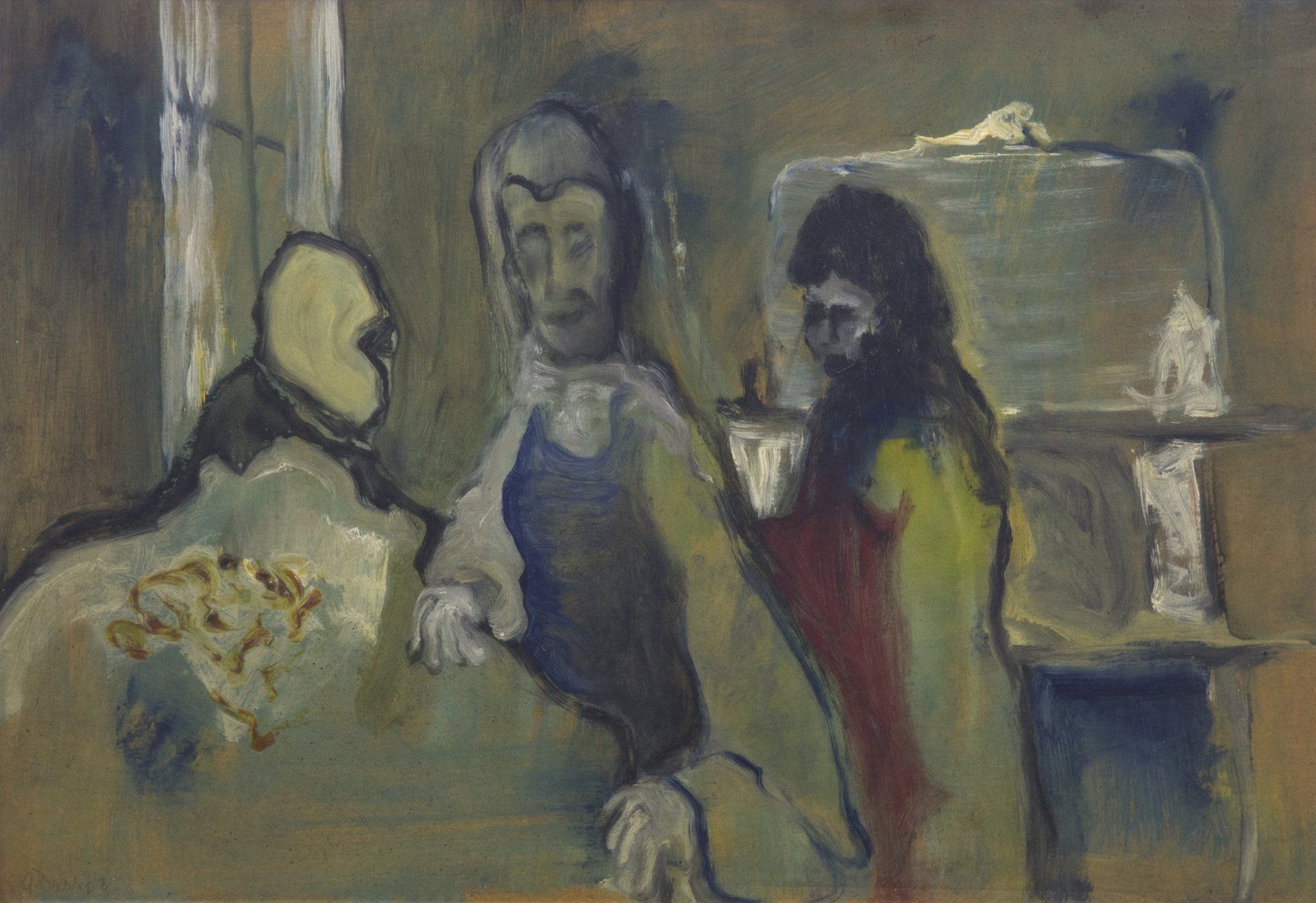Gerald Davis
'The Sisters'
A closer look by Charlotte Lang, volunteer at Olivier Cornet Gallery
"The spectre of Joyce looms in the paintings of Gerald Davis, who was a Jewish Dubliner and Joycean scholar. Born to Lithuanian Jewish parents in 1938, Davis was a prolific contemporary artist and gallery owner in Ireland who oft masqueraded as Ulysses’ Leopold Bloom in the Bloomsday parades.
His dark, amorphous landscapes reflect Joycean dreamscapes and through abstraction and toy with the harshness of urbanity. Joyce likened himself to a ‘stiff cathartic medicine’ to dispel the Irish imagination of illusions, his prose marked by a harsh realism for its unheroic subjects. In this there is his modernist, secular use of ‘epiphany’; a culminating image, a spiritual manifestation that lingers throughout the narratives. In this mimesis, Dublin is suspended in a paralysis of colonial rule, Catholicism and nationalist stupor. For me, The Sisters is necessarily historical, a dynamic engagement with Joyce’s emotional and urban landscape.
Davis’s The Sisters borrows from Joyce’s text of the same name [a chapter from 'Dubliners'], touching on mortality, liturgy and faith. It depicts the wake, where Joyce’s young protagonist confronts the body of Father Flynn. Placated by the ritualistic calm and order of the room, he expects the priest to be smiling but is instead confronted by his face ‘very truculent, grey and massive, with black cavernous nostrils’, his hands ‘loosely retaining a chalice’ as if vested for the altar, the room heavy with the odour of flowers. Davis retains this sense of encroachment through the use of green umber tones, imparting a stifling malaise which melts into the figures. This is combined with a destabilizing lack of spatial construction, mirroring Joyce’s structural rhythm, undulating between acceptance and renouncement of penance and communion. The yellow tones forebode emotional decay and desolation. The diagonal lines of the coffin simultaneously evoke movement, which rather than contrasting the stifling air only contributes to the lethargy. I was particularly struck by the loose, oily strokes which create a spectral, supernatural quality, as if foreboding despair. The sinuous, translucent fingers which grope the coffin seem at once tender and glacial. The amorphous, featureless face of the young boy seems to merge into the coffin itself, a bedmate in oblivion. Depersonalized and devoid of detail, the figures seem to slip into a liminal space of consciousness. Their oily, elongated faces suggest a monstrosity that is at once mundane and gothic, reminiscent of Munch.
Joyce’s scene is looming with disillusionment and madness, the priest and his sisters a synecdoche for the Catholic Church. Platitudes of his ‘beautiful corpse’ soon give way to confessions of his erratic behaviour, his crossed life, his laughing to himself in the silence and aloneness of the confession box. This is crystalized in a crisis of devotion, where the prescriptions of the catechism are contrasted with encroaching decay. Davis seems to capture this palpably, shielded from the priest’s face we are confronted with something perverse in the liturgy of mourning."
Charlotte Lang
[Note by the gallerist: This work was part of 'Portrait of Gerald Davis as an Artist', our 2016 tribute show in memory of the artist to whom this gallerist owes so much. This work was also part of an exhibition curated by John Daly at Hillsboro Fine Art in 2006: 'Celebrating Gerald Davis'].

